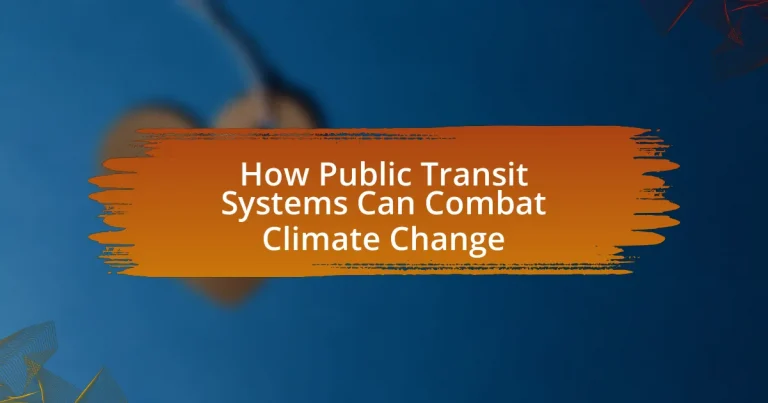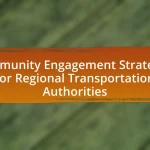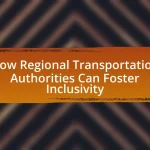Public transit systems play a crucial role in combating climate change by significantly reducing greenhouse gas emissions associated with personal vehicle use. By providing efficient transportation options, public transit encourages the use of buses, trains, and subways, leading to lower carbon footprints and improved air quality. The article outlines the environmental benefits of public transit, including its impact on urban congestion, energy efficiency, and sustainable urban development. It also addresses the challenges faced by transit systems, such as funding limitations and the need for technological advancements, while highlighting innovative strategies and community engagement as essential components for enhancing public transit’s effectiveness in addressing climate change.
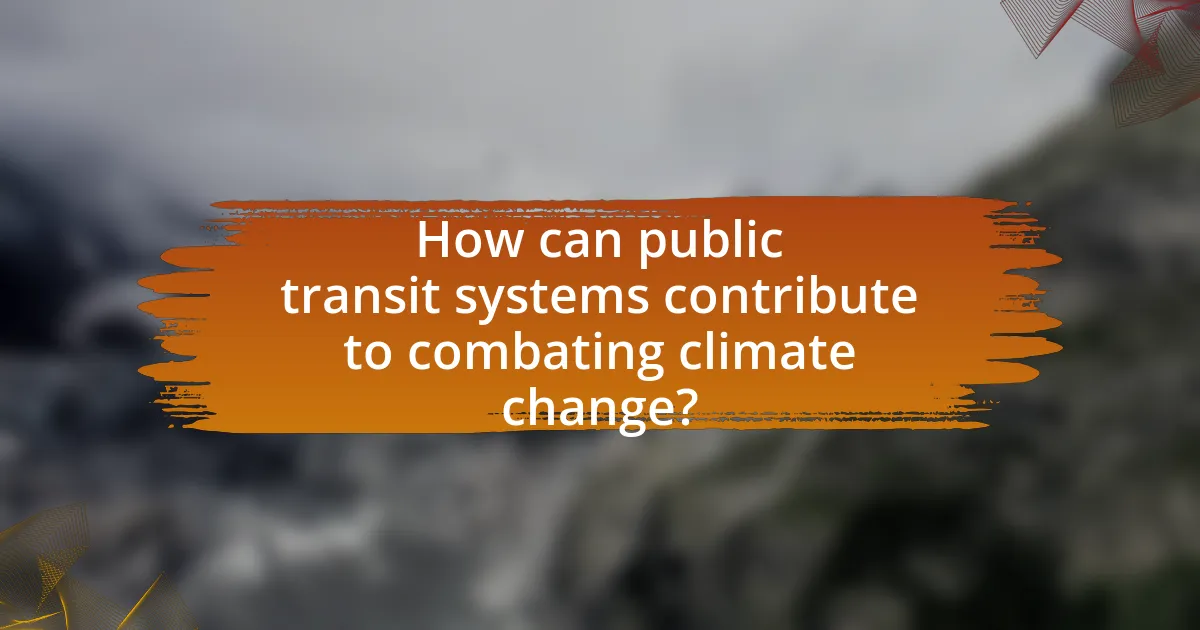
How can public transit systems contribute to combating climate change?
Public transit systems can significantly contribute to combating climate change by reducing greenhouse gas emissions associated with personal vehicle use. By providing efficient and accessible transportation options, public transit encourages people to opt for buses, trains, and subways instead of driving individual cars. For instance, the American Public Transportation Association reports that public transit saves approximately 45 million metric tons of carbon dioxide annually, equivalent to the emissions from over 9 million cars. Additionally, public transit systems often utilize cleaner technologies, such as electric or hybrid vehicles, further decreasing their environmental impact. This shift not only lowers emissions but also promotes sustainable urban development, reducing traffic congestion and improving air quality.
What are the key environmental benefits of public transit systems?
Public transit systems significantly reduce greenhouse gas emissions, contributing to improved air quality and lower carbon footprints. By providing an alternative to single-occupancy vehicles, public transit can decrease the number of cars on the road, which in turn reduces traffic congestion and the associated emissions. For instance, the American Public Transportation Association reports that public transit saves approximately 45 million metric tons of carbon dioxide annually, equivalent to the emissions from 9.5 million cars. Additionally, public transit systems promote energy efficiency, as they typically consume less energy per passenger mile compared to private vehicles. This efficiency is crucial in combating climate change and fostering sustainable urban development.
How does public transit reduce greenhouse gas emissions?
Public transit reduces greenhouse gas emissions by providing a more efficient alternative to single-occupancy vehicles, thereby decreasing the number of cars on the road. According to the American Public Transportation Association, public transit saves approximately 45 million metric tons of carbon dioxide annually, which is equivalent to the emissions from 9.5 million cars. By facilitating higher passenger capacity and promoting shared rides, public transit systems significantly lower per capita emissions compared to private vehicle use.
What role does public transit play in reducing urban congestion?
Public transit significantly reduces urban congestion by providing an efficient alternative to single-occupancy vehicles. By increasing the number of passengers per vehicle, public transit systems can decrease the overall number of cars on the road. For instance, a study by the American Public Transportation Association found that public transit use in the United States saves approximately 4.2 billion gallons of gasoline annually, which translates to a reduction of 37 million metric tons of carbon dioxide emissions. This reduction in vehicle usage directly correlates with decreased traffic congestion, as fewer cars lead to less gridlock and shorter travel times for all road users.
Why is public transit considered a sustainable transportation option?
Public transit is considered a sustainable transportation option because it significantly reduces greenhouse gas emissions per passenger compared to private vehicles. For instance, the American Public Transportation Association reports that public transit saves approximately 45 million metric tons of carbon dioxide annually, which is equivalent to the emissions from 9.5 million cars. Additionally, public transit systems promote higher density urban development, which minimizes land use and preserves green spaces, further contributing to environmental sustainability.
How does public transit promote energy efficiency?
Public transit promotes energy efficiency by reducing the number of individual vehicles on the road, which leads to lower overall fuel consumption. For instance, a study by the American Public Transportation Association found that public transit saves approximately 4.2 billion gallons of gasoline annually, which translates to a significant reduction in greenhouse gas emissions. Additionally, public transit systems often utilize energy-efficient vehicles and technologies, further enhancing their energy-saving capabilities. By providing a viable alternative to personal car travel, public transit effectively decreases traffic congestion and promotes a more sustainable urban environment.
What are the long-term impacts of public transit on urban planning?
Public transit significantly influences long-term urban planning by promoting sustainable development, reducing traffic congestion, and enhancing land use efficiency. Cities that invest in robust public transit systems often experience increased density around transit hubs, leading to mixed-use developments that minimize urban sprawl. For instance, a study by the American Public Transportation Association found that public transit can reduce greenhouse gas emissions by up to 45 million metric tons annually, demonstrating its role in combating climate change while shaping urban landscapes. Additionally, improved public transit accessibility fosters economic growth by attracting businesses and creating jobs, further solidifying its impact on urban planning.
What challenges do public transit systems face in addressing climate change?
Public transit systems face significant challenges in addressing climate change, primarily due to funding limitations, infrastructure inadequacies, and the need for technological upgrades. Funding constraints hinder the ability to invest in sustainable technologies and expand services, as many transit agencies operate on tight budgets. Infrastructure inadequacies, such as aging facilities and insufficient capacity, limit the effectiveness of public transit in reducing emissions. Additionally, the transition to cleaner technologies, such as electric buses, requires substantial investment and training, which many systems struggle to implement. According to the American Public Transportation Association, public transit can reduce greenhouse gas emissions by 45 million metric tons annually, but without addressing these challenges, the potential impact remains constrained.
How do funding and investment affect public transit initiatives?
Funding and investment significantly enhance public transit initiatives by providing the necessary financial resources for infrastructure development, operational improvements, and service expansions. For instance, the Federal Transit Administration reported that every dollar invested in public transit generates approximately four dollars in economic returns, which underscores the importance of financial backing in creating efficient transit systems. Moreover, increased funding allows for the adoption of cleaner technologies, such as electric buses, which can reduce greenhouse gas emissions and contribute to climate change mitigation. In 2020, the American Public Transportation Association noted that investments in public transit can lead to a 45% reduction in carbon emissions per passenger mile compared to single-occupancy vehicles, highlighting the direct impact of funding on environmental outcomes.
What technological advancements can enhance public transit’s effectiveness?
Technological advancements that can enhance public transit’s effectiveness include real-time tracking systems, electric and autonomous vehicles, and integrated payment solutions. Real-time tracking systems improve efficiency by providing passengers with accurate arrival times, which can increase ridership; for instance, cities like San Francisco have reported a 10% increase in bus ridership due to such systems. Electric vehicles reduce greenhouse gas emissions, aligning with climate change mitigation efforts, as they produce zero tailpipe emissions compared to traditional diesel buses. Autonomous vehicles can optimize routes and reduce operational costs, with studies indicating that they could lower transit costs by up to 40%. Integrated payment solutions streamline fare collection, making transit more user-friendly and encouraging more people to use public transport, as seen in cities like London, where contactless payments have significantly increased usage.

How can public transit systems be improved to better combat climate change?
Public transit systems can be improved to better combat climate change by increasing the adoption of electric and hybrid vehicles, enhancing service frequency, and expanding coverage areas. Transitioning to electric buses and trains reduces greenhouse gas emissions significantly; for instance, electric buses can cut emissions by up to 70% compared to diesel buses. Increasing service frequency encourages higher ridership, which can lead to a reduction in individual car use; studies show that a 10% increase in service frequency can boost ridership by 15%. Expanding coverage to underserved areas ensures equitable access to public transit, further decreasing reliance on personal vehicles. These strategies collectively contribute to a more sustainable public transit system that effectively addresses climate change.
What innovative strategies can be implemented in public transit systems?
Innovative strategies that can be implemented in public transit systems include the integration of electric and hybrid vehicles, the use of real-time data analytics for route optimization, and the development of multimodal transit hubs. Electric and hybrid vehicles reduce greenhouse gas emissions significantly; for instance, electric buses can cut emissions by up to 70% compared to traditional diesel buses. Real-time data analytics enhances efficiency by allowing transit agencies to adjust routes and schedules based on demand, which can lead to a 20% increase in ridership, as evidenced by studies from the Transportation Research Board. Additionally, multimodal transit hubs facilitate seamless connections between different modes of transport, encouraging the use of public transit over personal vehicles, thereby reducing overall carbon footprints.
How can electrification of transit vehicles reduce emissions?
Electrification of transit vehicles can significantly reduce emissions by replacing fossil fuel-powered engines with electric motors, which produce zero tailpipe emissions. This transition leads to a decrease in greenhouse gases and air pollutants, as electric vehicles (EVs) can be powered by renewable energy sources such as solar or wind. For instance, a study by the Union of Concerned Scientists indicates that electric buses can reduce greenhouse gas emissions by 50% compared to diesel buses over their lifetime, especially when charged with clean energy. Additionally, the overall efficiency of electric drivetrains is higher than that of internal combustion engines, further contributing to lower emissions.
What role does integrated multimodal transportation play in sustainability?
Integrated multimodal transportation significantly enhances sustainability by optimizing resource use and reducing greenhouse gas emissions. This approach combines various transportation modes, such as buses, trains, bicycles, and walking, to create a seamless travel experience that encourages public transit usage over single-occupancy vehicles. Research indicates that cities with integrated multimodal systems can reduce carbon emissions by up to 30% compared to those relying solely on personal vehicles. Furthermore, studies show that efficient multimodal networks can lead to increased public transit ridership, which in turn decreases traffic congestion and air pollution, contributing to overall environmental sustainability.
How can community engagement enhance public transit initiatives?
Community engagement can enhance public transit initiatives by fostering collaboration between transit authorities and local residents, leading to more effective and tailored transit solutions. Engaged communities provide valuable insights into their specific transportation needs, preferences, and challenges, which can inform the design and operation of transit services. For instance, a study by the Transportation Research Board found that public involvement in transit planning processes significantly increases ridership and satisfaction levels, as services are better aligned with community expectations. Additionally, community engagement can build public support for transit initiatives, facilitating funding and policy changes necessary for implementation.
What are effective ways to raise public awareness about transit benefits?
Effective ways to raise public awareness about transit benefits include targeted educational campaigns, community engagement initiatives, and partnerships with local organizations. Educational campaigns can utilize social media, local news outlets, and public events to disseminate information about the environmental, economic, and social advantages of public transit. For instance, studies show that public transit reduces greenhouse gas emissions by 45 million metric tons annually in the U.S. alone, highlighting its role in combating climate change. Community engagement initiatives, such as workshops and public forums, can foster dialogue and allow residents to share their experiences and suggestions regarding transit services. Collaborating with local organizations, such as schools and businesses, can amplify outreach efforts and create a network of advocates who promote transit benefits within their communities.
How can public feedback shape transit system improvements?
Public feedback can significantly shape transit system improvements by providing insights into user experiences and needs. Transit authorities can analyze feedback to identify areas requiring enhancement, such as service frequency, route efficiency, and accessibility. For instance, a study by the American Public Transportation Association found that systems incorporating public input saw a 20% increase in user satisfaction and ridership. This data demonstrates that when transit agencies actively engage with the community, they can implement targeted improvements that align with public expectations, ultimately leading to more effective and sustainable transit solutions.
What policies can support the growth of sustainable public transit?
Policies that can support the growth of sustainable public transit include increased funding for public transportation infrastructure, implementation of low-emission vehicle standards, and the development of integrated land-use planning. Increased funding allows for the expansion and maintenance of transit systems, which can lead to higher ridership and reduced reliance on personal vehicles. Low-emission vehicle standards encourage the adoption of cleaner technologies, reducing greenhouse gas emissions from public transit fleets. Integrated land-use planning promotes transit-oriented development, which can enhance accessibility and encourage the use of public transit over personal vehicles. These policies collectively contribute to a more sustainable public transit system, helping to combat climate change by reducing overall emissions and promoting efficient transportation options.
How can government incentives promote public transit usage?
Government incentives can promote public transit usage by reducing costs for riders and improving service quality. Financial incentives such as subsidies, tax credits, or reduced fares make public transit more affordable, encouraging more people to choose it over personal vehicles. For instance, a study by the American Public Transportation Association found that every $1 invested in public transit generates approximately $4 in economic returns, highlighting the effectiveness of financial support in increasing ridership. Additionally, investments in infrastructure improvements funded by government incentives can enhance the reliability and convenience of public transit, further attracting users.
What regulations are necessary to ensure environmentally friendly practices?
Regulations necessary to ensure environmentally friendly practices include stringent emissions standards for public transit vehicles, mandates for the use of renewable energy sources, and requirements for sustainable infrastructure development. Emissions standards, such as those set by the Environmental Protection Agency, limit pollutants from buses and trains, thereby reducing air quality degradation. Mandates for renewable energy, like the California Renewable Portfolio Standard, require transit agencies to source a percentage of their energy from renewable sources, promoting cleaner energy use. Additionally, regulations that enforce sustainable infrastructure, such as the LEED certification for buildings, ensure that transit facilities are designed with environmental considerations in mind. These regulations collectively contribute to reducing the carbon footprint of public transit systems and combating climate change effectively.
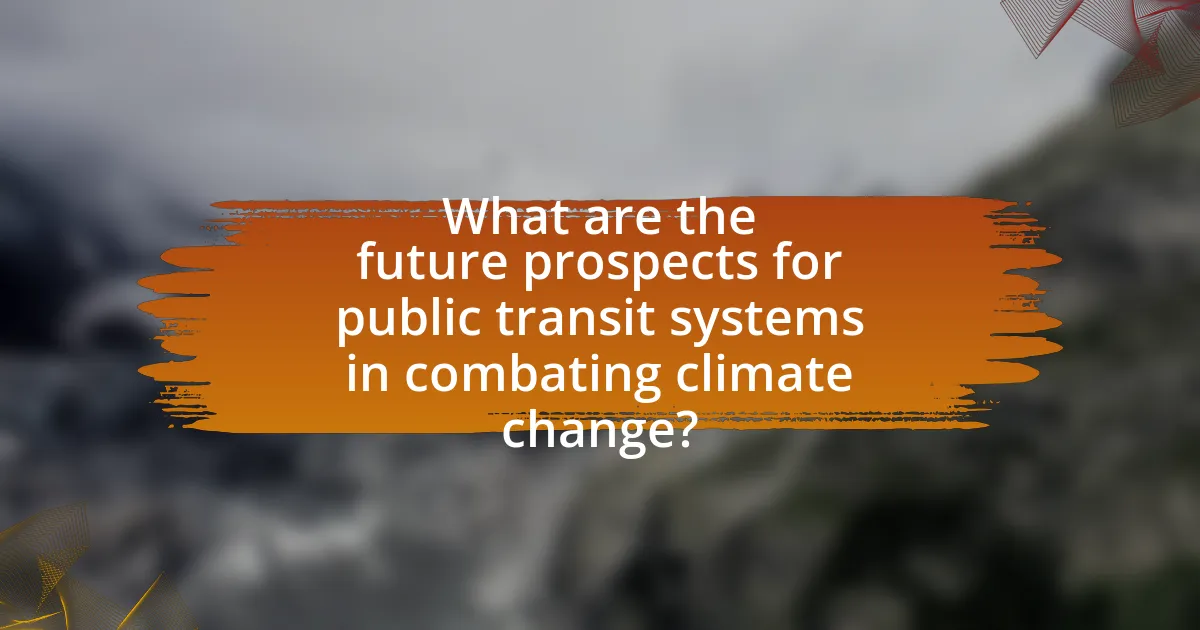
What are the future prospects for public transit systems in combating climate change?
Public transit systems have significant future prospects in combating climate change by reducing greenhouse gas emissions and promoting sustainable urban mobility. As cities expand and populations grow, the demand for efficient public transit will increase, leading to investments in cleaner technologies such as electric buses and trains. According to the American Public Transportation Association, public transit use can reduce individual carbon footprints by up to 45% compared to driving alone. Furthermore, integrating transit systems with renewable energy sources can enhance their sustainability, making them pivotal in achieving climate goals. The shift towards smart transit solutions, including real-time data and improved connectivity, will also encourage higher ridership and further decrease reliance on personal vehicles, thereby mitigating climate change impacts.
How is technology shaping the future of public transit?
Technology is shaping the future of public transit by enhancing efficiency, accessibility, and sustainability. Innovations such as real-time tracking systems improve operational efficiency, allowing transit agencies to optimize routes and schedules based on actual demand. For instance, cities like Los Angeles have implemented mobile apps that provide real-time updates, significantly increasing ridership. Additionally, electric and autonomous vehicles are being integrated into public transit fleets, reducing greenhouse gas emissions and reliance on fossil fuels. According to a report by the International Energy Agency, electric buses can reduce emissions by up to 70% compared to traditional diesel buses. Furthermore, data analytics and artificial intelligence are being utilized to predict transit patterns and improve service delivery, making public transit more responsive to community needs. These technological advancements collectively contribute to a more sustainable public transit system, aligning with climate change mitigation efforts.
What advancements in data analytics can optimize transit operations?
Advancements in data analytics that can optimize transit operations include real-time data processing, predictive analytics, and machine learning algorithms. Real-time data processing allows transit agencies to monitor vehicle locations and passenger loads, enabling dynamic route adjustments and improved service reliability. Predictive analytics utilizes historical data to forecast demand patterns, helping agencies allocate resources more efficiently and reduce wait times. Machine learning algorithms analyze vast datasets to identify trends and optimize scheduling, leading to enhanced operational efficiency. For instance, cities like Los Angeles have implemented these technologies, resulting in a reported 15% increase in on-time performance and a significant reduction in operational costs.
How can autonomous vehicles impact public transit systems?
Autonomous vehicles can significantly enhance public transit systems by improving efficiency, reducing operational costs, and increasing accessibility. These vehicles can optimize routes and schedules through real-time data analysis, leading to more reliable service. For instance, a study by the American Public Transportation Association found that integrating autonomous shuttles into existing transit networks can increase ridership by up to 20%, as they provide first-mile and last-mile connectivity. Additionally, autonomous vehicles can lower emissions by facilitating the use of electric fleets, contributing to climate change mitigation efforts.
What role do partnerships play in enhancing public transit sustainability?
Partnerships play a crucial role in enhancing public transit sustainability by facilitating resource sharing, innovation, and community engagement. Collaborative efforts between government agencies, private companies, and non-profit organizations lead to the development of more efficient transit systems, as evidenced by initiatives like the partnership between the Los Angeles County Metropolitan Transportation Authority and various tech firms to implement smart transit solutions. These partnerships enable the integration of sustainable technologies, such as electric buses and renewable energy sources, which significantly reduce greenhouse gas emissions. Furthermore, partnerships foster community involvement, ensuring that transit solutions meet local needs and promote ridership, ultimately contributing to a more sustainable public transit ecosystem.
How can collaboration between public and private sectors improve transit solutions?
Collaboration between public and private sectors can significantly enhance transit solutions by leveraging resources, expertise, and innovation. Public entities can provide regulatory frameworks and funding, while private companies can introduce advanced technologies and operational efficiencies. For instance, partnerships in cities like Los Angeles have led to the implementation of smart transit systems that optimize routes and reduce wait times, resulting in a 20% increase in ridership. This synergy not only improves service quality but also fosters sustainable practices, as seen in initiatives where private firms invest in electric buses, aligning with climate goals.
What examples exist of successful public transit partnerships?
Successful public transit partnerships include the collaboration between the Bay Area Rapid Transit (BART) and the San Francisco Municipal Transportation Agency (SFMTA), which integrates services to provide seamless travel across the region. This partnership has led to increased ridership and reduced vehicle emissions, contributing to climate change mitigation efforts. Another example is the partnership between the Chicago Transit Authority (CTA) and the City of Chicago, which focuses on expanding electric bus fleets and enhancing service efficiency, resulting in lower greenhouse gas emissions. These partnerships demonstrate effective strategies for improving public transit while addressing environmental concerns.
What practical steps can individuals take to support public transit initiatives?
Individuals can support public transit initiatives by advocating for increased funding and resources for public transportation systems. Engaging with local government representatives to express the importance of public transit can lead to policy changes that prioritize sustainable transportation options. Additionally, individuals can participate in community meetings focused on transit planning, providing input on service improvements and expansions. Supporting local transit agencies through social media campaigns and public awareness efforts can also enhance visibility and community engagement. According to the American Public Transportation Association, every $1 invested in public transit generates approximately $4 in economic returns, highlighting the significant impact of advocacy and support for these initiatives.
How can community members advocate for better public transit options?
Community members can advocate for better public transit options by organizing campaigns that highlight the benefits of improved transit systems, such as reduced traffic congestion and lower greenhouse gas emissions. Engaging with local government officials through public meetings and forums allows residents to voice their needs and preferences directly. Additionally, forming coalitions with environmental organizations can amplify their message, as studies show that public transit can reduce individual carbon footprints by up to 45% compared to driving alone. By presenting data and case studies from successful transit initiatives in other cities, community members can effectively argue for increased funding and support for public transit improvements.
What are the best practices for using public transit to reduce personal carbon footprints?
Using public transit effectively can significantly reduce personal carbon footprints. Best practices include planning trips in advance to utilize direct routes, which minimizes travel time and emissions. Additionally, choosing to travel during off-peak hours can lead to less crowded vehicles, enhancing comfort and efficiency. Regularly using public transit instead of personal vehicles decreases reliance on fossil fuels; studies show that public transit can reduce greenhouse gas emissions by 45% per mile compared to single-occupancy vehicles. Furthermore, combining trips and using transit for errands can further decrease the number of trips taken, leading to lower overall emissions. Engaging in community advocacy for improved public transit options can also contribute to a more sustainable system, encouraging more individuals to utilize these services.
